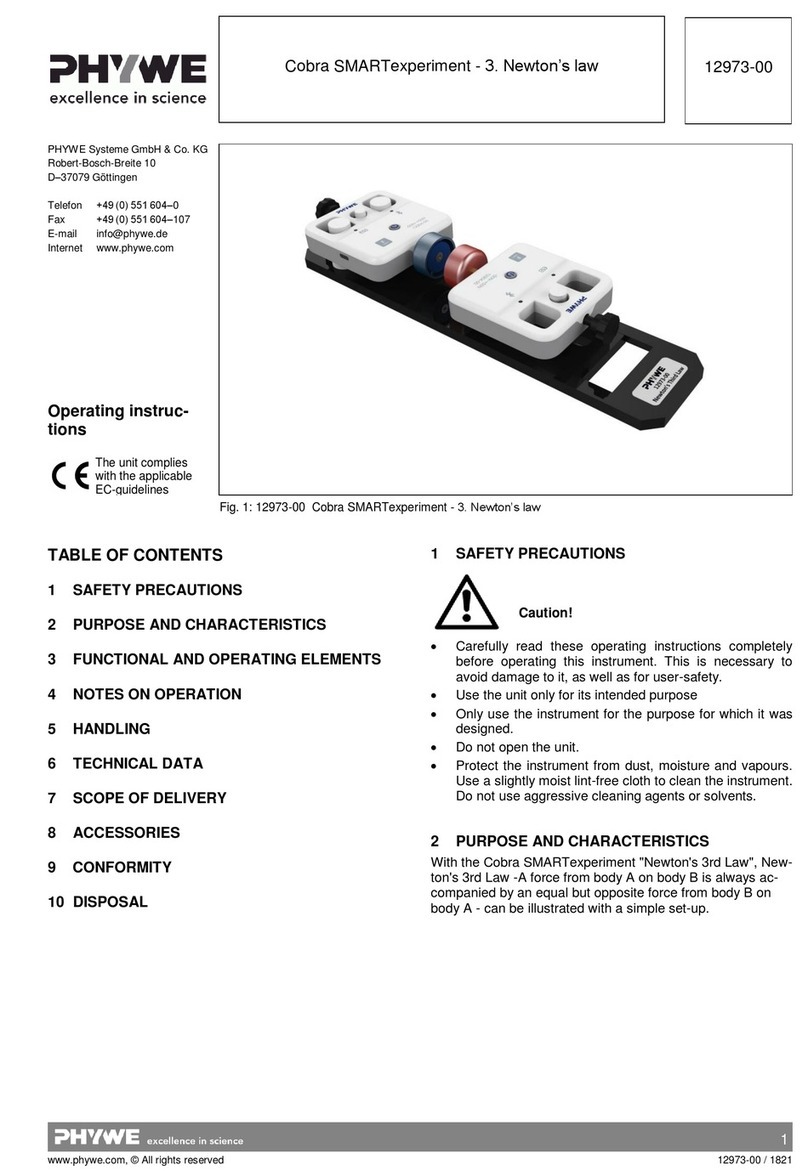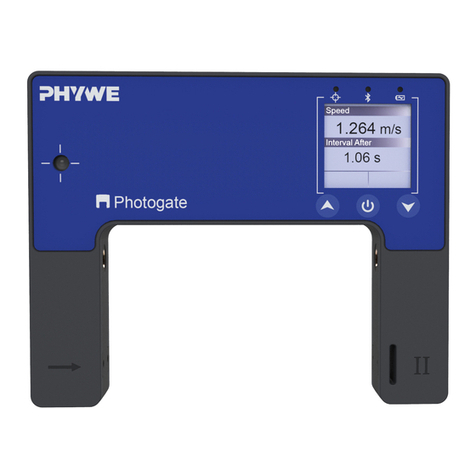– alcohol reservoir (removable) with a double tubing
assembly which can be screwed off (12)
– main switch (4)
– switch „continuous operation - timer“ (5)
– swtich „high voltage“ (6)
– knurled nut for alcohol supply (11)
– control knob for gutter heating (7)
– programmable time switch (8)
– safety cutout (9)
When you have connected the cloud chamber to mains and
opened the front side, remove the alcohol reservoir (12) from
its installation place and unscrew the union nut (13) of the
double tubing assembly.
Fill the alcohol reservoir three quarters full (see section 7
“Notes on handling iso-propanol”), fit the double tubing
assembly on again and the alcohol reservoir back in place).
Now activate the switches as follows:
main switch (4): ON
mode (5): continuous operation
high voltage(6): ON
The knurled nut (11) serves for regulating the amount of
alcohol dropping into the evaporating gutter. Turn the the
knurled nut to the left and observe the alcohol flowing
through the bended tube (14) and dropping into the gutter.
When the gutter is filled to a liquid level of about 1 cm, reduce
the alcohol supply to about 6 - 8 droplets per second. When
the cloud chamber is being operated, the alcohol in the gutter
should remain constant at this level. After about 5 minutes,
the first white tracks should appear on the black observation
surface. If, however, after 1 hour the tracks become a bit
fuzzy and milky, you have to reduce the gutter heating by
means of the control knob (7).
If the tracks are too weak, the heating of the gutter must be
increased.
If you want to run the cloud chamber at automatic operation,
set the markers of the programmable time switch to the
desired switching time (red marker to switch the cloud
chamber on, green marker to switch it off) and set the mode
switch (5) to „timer“. For more detailed information see the
instructions on the programmable time switch.
Now close the front side by inserting the plate (3) into the
right side of the opening, pushing it back to the left stop
position and locking it up.
How to open the back side:
Important!
It is only allowed to open the back front. by qualified
personal.The back side can be opened and closed just like
the front side. Here you can see the cooling element, the
thermostat and the inspection glass (21) for the cooling liquid.
During the operation of the cloud chamber the inspection
glass should always be filled with cooling liquid. Make sure
that there are no bubbles in the glass.
The thermostat comes supplied set to the optimum
temperature. In the case of extreme room temperatures, it
might become necessary to modify the setting by turning the
knob on the upper part of the thermostat. Please make sure
that modifications on the cooling element are only
carried out by authorized experts.
The upper part of the glass hood includes an electrically
heated gutter (15) which runs around the whole
circumference. Iso-propyl alcohol flows through a bended
tube (14) and drops into the gutter.
The alcohol evaporates and diffuses from the upper, warmer
area of the chamber to the cold chamber bottom. There the
alcohol is condensed into tiny droplets and flows back into
the reservoir.
Right above the thin liquid layer covering the bottom a zone
of oversaturated alcohol vapour is formed. It’s in this area,
and only in this area, that the charged material particles
coming from the inside or from the outside produce ions
along their trajectory. The tiny alcohol droplets preferably
attach to these ions thus producing a visible cloud track. The
length and the structure of the cloud track give information on
the kind of ionizing particles.
4TRANSPORT OF THE CLOUD CHAMBER
Important!
It is vital to ensure the cloud chamber is not tilted (< 10° from
the vertical) during transport, as otherwise the refrigeration
system will be irreparably damaged.
Transport of a cloud chamber (e.g. change in the place of
installation) should not be carried out with an evaporating
duct full of alcohol. Adrain valve has now been additionally
fitted into the cloud chamber for the draining of the alcohol
from the evaporating duct. This drain valve can be regulated
with a knob which is positioned above the milled screw for the
regulation of the alcohol feed-in (11). Open the drain valve to
allow alcohol to flow back into the alcohol container (12).
Close the drain valve as soon as the evaporating duct is
empty.
5INSTALLATION OF THE CLOUD CHAMBER
In order to guarantee an optimum view on the observation
chamber, it is recommended to place the chamber onto a
square table (border length about 90 to 100 cm) which should
be about 60 cm high. Since the weight of the cloud chamber
is 80 kg, the table must be massive enough to carry this load.
Please make sure that the ventilating slots (19) are not
covered and that the cloud chamber is not subjected to direct
light coming from above. Aslightly darkened room would be
perfect. Use the connecting cable supplied to connect the
cloud chamber to mains. The mains connection (1) is located
down on the back side. The corresponding mains socket
should be protected for max. 16 A.
Adjust the cloud chamber on an absolutely horizontal level
with the aid of the adjustable feet (16) in order to provide an
even alcohol level in the gutter and thus a clear image.
6INITIAL OPERATION
The base of the cloud chamber can be accessed from two
sides. Unlock the lock (2 or 3) to open the two sides, push the
side plate a few centimeters to the right and then carefully
pull it towards you thus lifting it out of the base.
On the front side you can now find a panel with the following
components and operating elements:



























